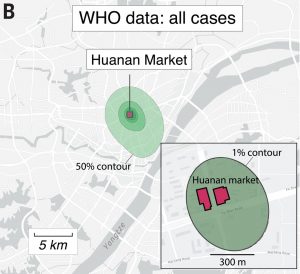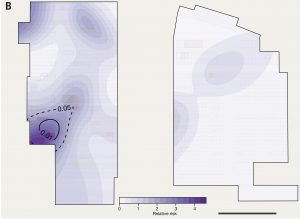Geographical Model Pinpoints COVID-19 Outbreak Epicenter
Written by: Kohl Vonder Haar
The COVID-19 pandemic has proven to be one of the direst health crises of the twenty-first century, killing upwards of 6.5 million people and infecting more than 633 million globally within the span of three years. COVID-19 is caused by SARS-CoV-2, a coronavirus that originated in domestic animals and likely mutated before spreading to humans. Researchers have long wondered about which animal species first carried the virus and where it may have originated from. The initial source of the disease remained unknown until a recent study published in Science concluded that the disease was first transmitted to humans by selling live mammals in the Huanan Seafood Wholesale Market in Wuhan, China.
Prior Outbreak Theories and Research Motivations
The sources of COVID-19 have been highly debated since its initial discovery in the United States in January 2020. Though it was determined to have been transmitted to humans from animals early in the pandemic, the specific species and source that it originated from were unclear. One of the earliest known possible sources of the virus was bats, as the bat coronavirus RaTG13 has been found to be 96% genetically identical to SARS-CoV-2. Another speculated animal source of COVID-19 was pangolins, as the spike proteins of SARS-CoV-2, proteins that allow viruses to penetrate host cells, were found to be 91.02% similar to those found in a genetically reconstructed pangolin coronavirus. However, the findings of previous studies analyzing the species from which COVID-19 originated were highly inconclusive, lacking concrete evidence to directly pinpoint the original species from which the outbreak emanated. These studies also severely undermined the importance of evaluating the initial COVID-19 outbreak location, finding it to be insignificant beyond the known location of the initial outbreak in Wuhan, China. Knowing the precise location of the initial outbreak would play a significant role in determining crucial information, such as precisely what species initially transmitted the disease and the ecosystems and habitats they originated from. This information would guide nations in preventing the spread of deadly diseases like coronaviruses and developing programs and protocols to mitigate their outbreaks initially. With this in mind, Dr. Worobey and his team undertook their work to evaluate the initial outbreak location and possible species that may have carried SARS-CoV-2 into humans.
Infection Analysis
Under Dr. Michael Worobey, a research team of biologists from fifteen different institutions found that the most likely source of the initial outbreak of COVID-19 was the Huanan Seafood Wholesale Market. The researchers used a technique called a kernel density estimate to evaluate the location with the largest margin of reported cases originating from it. A kernel density estimate uses functions that are only non-zero over an interval as weights to determine the probability density function of a variable without relying on parametrized data, allowing it to be particularly useful in evaluating location data. The researchers found that, following the 155 reported cases in Wuhan, China, in December of 2019, the highest density of reported cases to the 1% margin could be found within a less than 500-meter distance from the Huanan market, as shown in Figure 1. In addition, when compared to the age-adjusted data, all types of COVID-19 cases were found to be significantly closer to the market than expected, disproving sampling biases. The Huanan market must be the epicenter of the first coronavirus epidemic, but another question persists: how did the disease first infect humans?
Figure 1

Graph depicting the smallest density contour of COVID-19 cases in Wuhan, China, per their initial home location, at the 50, 25, 10, 5, and 1 percent margins.
Source: Science.org
Initial Infection Causes
In parallel with the researchers’ findings, the majority of positive samples of the coronavirus in the Huanan market could be traced back to businesses and stalls in the southwest sector, as shown in Figure 2. Five stalls in this section were known to be selling illegal meat products and live animals, including red foxes, Chinese hares, Asian badgers, hog badgers, and raccoon dogs. One of these stalls selling live animals was found to have five positive samples of COVID-19 near it, in addition to a nearby stall featuring more positive samples. The employees working at these stands were among the first 155 positive cases in December 2019. However, they did not live near the market, affirming that the trade and exposure to these live animals caused the coronavirus outbreak.
Figure 2

Graph showing the relative risk of positive COVID-19 samples in particular stalls at the Huanan Seafood Wholesale Market, with darker shades indicating higher risk; contours depict regions with statistically significant rises in SARS-CoV-2 positive samples compared to the distribution of positive samples among the stalls.
Source: Science.org
Conclusion
Dr. Worobey and his team provide concrete evidence for the claim that the Huanan Seafood Wholesale Market was ground zero for the deadly COVID-19 pandemic. Those findings make sense, especially since the market was located within the smallest density interval of all 155 officially recorded cases in December 2019 and contained the first samples of SARS-CoV-2 by live animal sale. Armed with this knowledge, we can better understand how to prevent the spread of new coronavirus variants and how the sale of live animals can serve as one of the leading causes of disease spillover and spread. In the future, we must make an effort to mitigate the sale of live animals, being one of the leading causes of epidemic outbreaks, and conduct further research into how live animal farming and sale can impact the spread of diseases itself.
References and Sources
Cuffari, B. (2021, February 24). What are Spike Proteins? News Medical. Retrieved November 29, 2022, from https://www.news-medical.net/health/What-are-Spike-Proteins.aspx
Lytras, S., Xia, W., Hughes, J., Jiang, X., & Robertson, D. L. (2021). The Animal Origin of SARS-COV-2. Science, 373(6558), 968–970. https://doi.org/10.1126/science.abh0117
Rahman, H. S., Aziz, M. S., Hussein, R. H., Othman, H. H., Salih Omer, S. H., Khalid, E. S., Abdulrahman, N. A., Amin, K., & Abdullah, R. (2020). The transmission modes and sources of covid-19: A systematic review. International Journal of Surgery Open, 26, 125–136. https://doi.org/10.1016/j.ijso.2020.08.017
Wong, M. C., Javornik Cregeen, S. J., Ajami, N. J., & Petrosino, J. F. (2020). Evidence of recombination in coronaviruses implicating pangolin origins of nCoV-2019. BioRxiv. https://doi.org/10.1101/2020.02.07.939207
World Health Organization. (2022, September 18). WHO Coronavirus (COVID-19) Dashboard. World Health Organization. Retrieved from https://covid19.who.int/
Worobey, M., Levy, J. I., Malpica Serrano, L., Crits-Christoph, A., Pekar, J. E., Goldstein, S. A., Rasmussen, A. L., Kraemer, M. U., Newman, C., Koopmans, M. P., Suchard, M. A., Wertheim, J. O., Lemey, P., Robertson, D. L., Garry, R. F., Holmes, E. C., Rambaut, A., & Andersen, K. G. (2022). The Huanan Seafood Wholesale Market in Wuhan was the early epicenter of the COVID-19 pandemic. Science, 377(6609), 951–959. https://doi.org/10.1126/science.abp8715